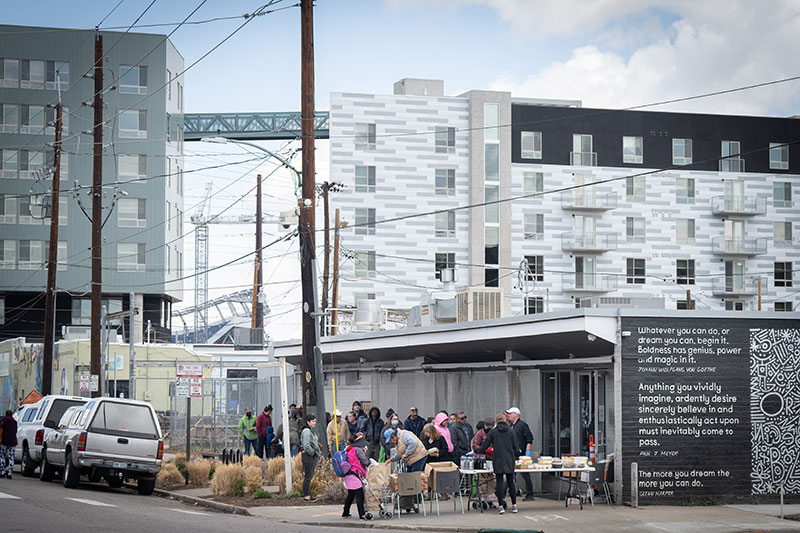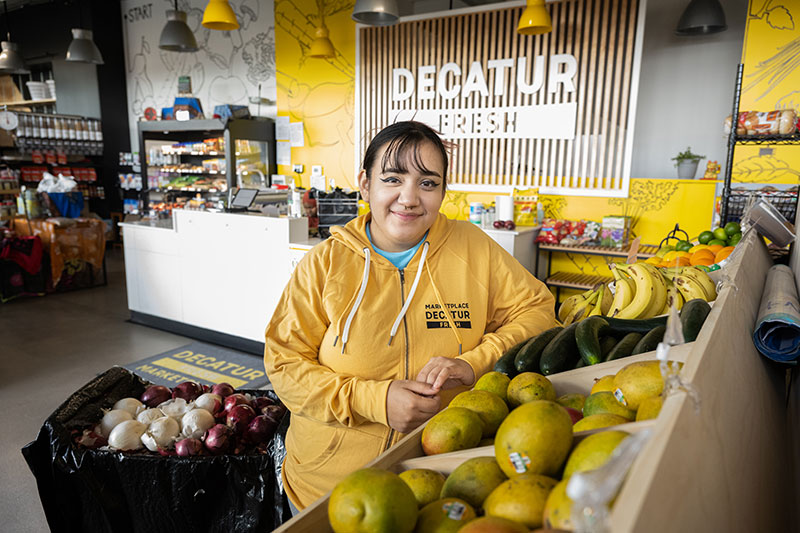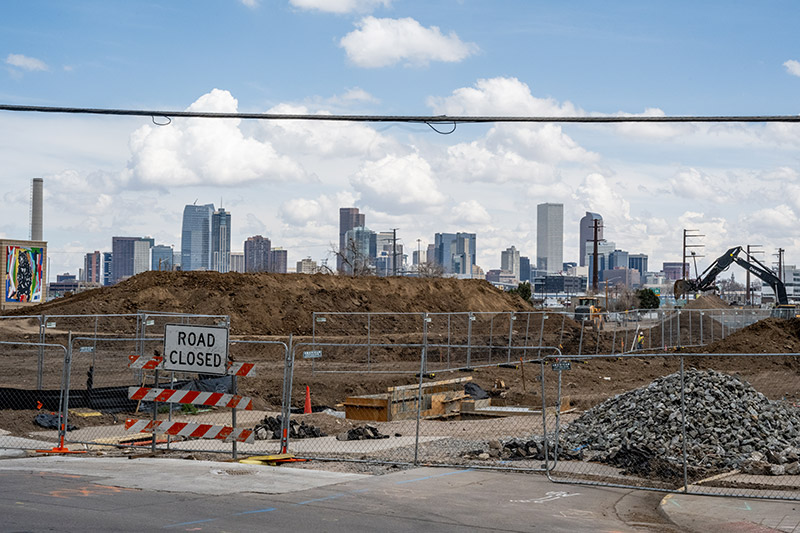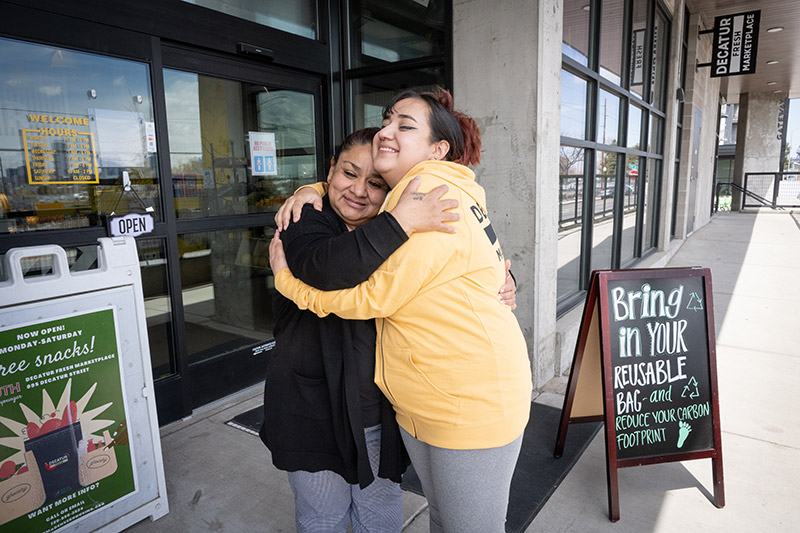
Scarlett Nohr outside the Sun Valley Kitchen and Community Center on April 15, 2023. Nohr and her family were among the few people not relocated as part of the Sun Valley redevelopment project. Photos by Ellen Jaskol / Special to The Colorado Trust
Scarlett Nohr outside the Sun Valley Kitchen and Community Center on April 15, 2023. Nohr and her family were among the few people not relocated as part of the Sun Valley redevelopment project. Photos by Ellen Jaskol / Special to The Colorado Trust
In Scarlett Nohr’s old duplex apartment in a large public housing complex in Denver’s Sun Valley neighborhood, the shower leaked so heavily, black mold inched across the bathroom wall. During winters, cold crept through the poorly sealed windows, and there was no air conditioning so summers were brutally hot. The buildings were so dilapidated that the walls were literally crumbling; Nohr was constantly sweeping up chunks of debris.
The nice thing was the river. The South Platte, which forms the eastern boundary of the neighborhood, located just west of downtown Denver, was one of the only park-like spaces accessible to Sun Valley residents. Yet the grounds of the complex where Nohr, 63, lived with her two children were in disrepair. A few years after they moved in, Denver Housing Authority (which administers funds from the U.S. Department of Housing and Urban Development, or HUD, in the Denver area) stopped watering the lawns, which were covered in geese feces.
“It looked horrible,” Nohr said.
For decades, Sun Valley has been among the city’s poorest and most marginalized neighborhoods, with 80% of people there living in poverty, the vast majority of them renters in public housing projects. Isolated from the rest of the city by highways, train tracks, the river and dead-end streets, on the outside Sun Valley exemplified how areas of concentrated poverty reinforced the negative outcomes many community members faced, like high crime, poor mental and physical health, low school achievement, and an inability to escape poverty.
A decade ago, Denver Housing Authority (DHA) began an ambitious redevelopment plan for Sun Valley that would not just rebuild the dilapidated housing projects, but transform the entire neighborhood into a mixed-income community. With total public and private investment expected to be in the $500-$600 million range, the goal is to blend subsidized and free-market units, improve community connectivity, build more open space and better access to food, and provide new opportunities for economic development and jobs.
DHA had to relocate most of the roughly 1,000 residents of the old Sun Valley Homes complex while they tore down and rebuilt the subsidized housing. (About 70 families, including Nohr’s family, were able to remain in the neighborhood during the construction.) In 2021, Nohr and her two adult children moved into one of the first two DHA-built apartment buildings that are part of the Sun Valley redevelopment. The buildings are a mix of affordable and free-market apartments—indistinguishable from each other—with modern appliances and large windows offering expansive views of nearby Empower Field, the Broncos’ stadium, and downtown Denver.
But for all that residents like Nohr have gained, others also feel a sense of loss over their old, tight-knit community, and fears over what will replace it. In the face of a nationwide public housing crisis, the mixed reviews offer an illustration of the challenges facing public housing development in increasingly gentrifying cities.

People line up for food at the Sun Valley Kitchen and Community Center, with several recently built apartment buildings visible in the background.
* * *
Built in 1958, the Sun Valley Homes were one of Denver’s oldest public housing projects—333 units spread out in one- and two-story townhome-style apartments along curved streets that gave the area a suburban feel.
It was the old public housing design of the 1950s and 1960s, said Jeanne Granville, president of the Sun Valley Community Coalition—namely, segregated and cut off from the surrounded urban environment, with few amenities or services. The failures of that model were exemplified in August 2014 in Ferguson, Mo. when police shot and killed Michael Brown, an unarmed Black teenager, unleashing a wave of protests. Brown’s death and the aftermath cast a spotlight on conditions in Ferguson where public housing complexes were built in a suburban area without integrating them into the city as a whole. The housing developments were racially segregated, with high poverty and unemployment, poor student achievement and oppressive policing.
The new Sun Valley was designed to break from that model: a mixed-use, mixed-income, denser, healthier and greener neighborhood oriented around public transit and connected to the city at large. The redevelopment was also part of a shift at the federal level to incorporate more of the private sector into public housing development, much of which is in disrepair as Congress has failed for decades to appropriate sufficient funds to HUD. Each year about 10,000 public housing apartments nationwide are lost to deterioration and the remainder need a combined $45 billion (and rising) in repairs. (Meanwhile, the federal government awarded $193 billion in mortgage-interest deductions and other subsidies to homeowners in 2020, as the sociologist Matthew Desmond points out in his new book, “Poverty, by America.”)
“They’re billions of dollars in the hole in regards to keeping public housing in quality standards of which they score us on through physical inspections,” said David Nisivoccia, the CEO of Denver Housing Authority, adding that much of the country’s public housing stock was built so long ago, it lacks modern amenities like adequate heat and air conditioning (or any air conditioning at all).
To address the lack of funding, DHA, like many other public housing authorities, has resorted to what Nisivoccia calls “lasagna financing” to upgrade existing public housing and build new affordable units. This multi-layered approach incorporates various financing tools like the federal Low-Income Housing Tax Credit; housing bonds; public-private partnerships like the Rental Assistance Demonstration program, which transfers public housing to private management; and various voucher programs that subsidize the rent either for a dedicated affordable unit or directly for an individual or family based on their income and household size.
The funding for the Sun Valley redevelopment had to come through a similar mixed bag of financing sources, including the City of Denver’s affordable housing fund, the Colorado Division of Housing, Colorado Housing and Finance Authority, developer fees, and a HUD grant program called the Choice Neighborhood Initiative. DHA received its first Choice Neighborhood Initiative grant in 2013 to create an ambitious master plan for the Sun Valley neighborhood. The goal of the program is not just to improve the quality of public housing but also employment, education and health outcomes for residents. To fund the necessary infrastructure improvements like new street grids, Choice Neighborhood Initiative grants incentivize bringing in private developers to build market-rate units alongside the affordable ones.
Teams of DHA representatives gathered input from Sun Valley residents about what gaps and problems existed in the neighborhood beyond low-quality housing, from being a food desert to the lack of green space and recreation facilities. The resulting master plan outlined a six-phase, $240 million redevelopment project for the Sun Valley Homes that would replace the existing 333 units of public housing and add over 950 new, mixed-income units as well a 212-unit DHA building dedicated for seniors and the disabled, according to Annie Hancock, director of resident and community connections at DHA. As part of the plan, DHA would sell 10 acres of its land to private developers for an additional 800 free-market units.
All in all, the public-private financing model had helped DHA triple the number of affordable units in Sun Valley, helping make a dent in Denver’s affordable housing deficit of 60,000 units—far more than the 350 yearly units DHA has the funds to build on its own. “You have to resort to all these creative tools to kind of piece it together to reach the need more,” said Nisivoccia.
* * *
Selena Ramirez was 10 years old when she moved into a red brick apartment in the old Sun Valley Homes complex with her mother and younger brother. For the first two years, Ramirez’s mom didn’t let them play outside—law enforcement activity in the area felt all too common, and other children living in the complex were seemingly unsupervised much of the time.

Selena Ramirez at Decatur Fresh Market in the Sun Valley neighborhood on April 25, 2023. Ramirez works at the market, but she and her family have not lived in Sun Valley since 2018, when they were relocated by Denver Housing Authority for the redevelopment project.
Tired of feeling isolated, Ramirez’s mom joined the local resident council, allowing her to connect more with her neighbors. Gradually, her fears eased and she allowed Ramirez and her brother to play outside. They made friends and felt connected to the wider community, which was eclectic and diverse, with different cultures and numerous languages spoken. There were block parties and communal celebrations for holidays like Chinese New Year.
News of the Sun Valley redevelopment trickled down to Ramirez and her friends through vague snippets. All the buildings would be knocked down, they heard; they assumed it was just rumors. But in time, they noticed things changing. There were community meetings where residents could offer input on various designs, from the individual apartments to the buildings to the riverside park alongside the South Platte.
Originally, the redevelopment plan promised an incremental approach, with several phases of staggered demolition and construction so that public housing residents could remain in the neighborhood throughout the process, offering some degree of stability and continuity. In other words, Sun Valley residents would not have to relocate out of the neighborhood while their housing was rebuilt.
But in the years since the original master plan was conceived, the world changed, throwing elements of the plan off track. The COVID-19 pandemic caused labor shortages and supply chain issues, which led to huge increases in construction costs—for some buildings, more than $20 million over projections, said Hancock, adding that just to finance building the housing component of the redevelopment, DHA has had to “get creative.” Permitting delays and unforeseen infrastructure challenges also meant DHA could not follow through on the plan to complete the community members’ relocation in phases instead of all at once.
All that is to say: All but 70 families in the original Sun Valley Homes had to relocate out of the neighborhood for the redevelopment.
Ramirez, now 23, didn’t want to leave Sun Valley, where she had her friends and her community—where everything was familiar. In a matter of months, Sun Valley went from being a vibrant neighborhood full of kids playing and families barbequing in their backyards to a construction zone devoid of people. In 2018, DHA helped Ramirez, her mother and her brother relocate to another DHA housing development one and a half miles east.
Hancock says that ultimately, DHA hopes 50% of the original Sun Valley residents will return once the redevelopment is complete, in line with the recent Mariposa District redevelopment, which replaced the old South Lincoln Park Homes public housing. So far, 20% of Sun Valley’s original residents have returned, with several more buildings yet to be completed, while nationwide, return rates for public housing redevelopments are around 15-20%, per Nisivoccia and Hancock.
This was and is a tension that’s sometimes difficult to reconcile, said Hancock: “You’re going to redesign this place, and a lot of people won’t end up coming back.” That reality created mixed feelings for many residents, including Ramirez, who knew the Sun Valley Homes were rundown and needed upgrading, but felt sad about how the relocations would impact her community.
“This is where you’ve grown up your whole life and you want to hold on to that,” she told me. “All these changes are happening around you, and you see it happening in other neighborhoods and it feels like gentrification.”
* * *
The Sun Valley Kitchen and Community Center occupies a bright café-like space with an open industrial kitchen in the heart of Sun Valley. On a weekday in early March, a few people were working on laptops, including Glenn Harper, the center’s founder and one of the few homeowners in the neighborhood. Originally a restaurant that doubles as a community center, Harper had to close the restaurant during the pandemic. He now offers cooking classes, community meals, a food bank, and other programming for kids and families in Sun Valley.

Glenn Harper, founder of the Sun Valley Kitchen and Community Center, prepares lunch and extra food for community members. April 25, 2023.
Harper acknowledged the unfortunate circumstances that prevented DHA from following through on its initial plan for the redevelopment, but was frustrated at the failure to deliver on the narrative it promised: a national model for low-income neighborhood transformation. “The reality is a lot of displacement of residents and initiatives that never happened,” he said, such as the youth and family hub center that is no longer getting built.
When Ramirez, the longtime Sun Valley resident, and her family were relocated out of the neighborhood, she assumed they’d be able to move back once the replacement buildings were complete. But Ramirez, her mother and brother haven’t been able to qualify for one of the new units in Sun Valley—their individual incomes would qualify, but as a household unit, their combined income is too high—leaving Ramirez disappointed. Like Harper, she felt like, “what we were told and what actually happened was different—like there were a lot of things that happened in the background.”
Hancock noted that DHA had to adapt to changes and barriers as they came up in the redevelopment process, and that the agency is still working in the neighborhood and striving to bring in more services and elements of the original master plan as much as possible.
Those challenges and disappointments are also a product of a flawed public housing model and its growing reliance on the private sector, said Carrie Makarewicz, PhD, an associate professor at the University of Colorado Denver and chair of its Urban and Regional Planning Department. In Sun Valley’s case, the federal Choice Neighborhood Initiative grant allowed DHA to formulate a robust and ambitious master plan, but did not guarantee funding to follow through on all aspects of the plan.
“We need to stop doing this model at the federal level that puts housing authorities in these precarious positions,” said Makarewicz, who also co-authored a study published in March 2023 on the Choice Neighborhood Initiative and the privatization of the Sun Valley redevelopment.

The six-phase, $240 million Sun Valley redevelopment plan aims to triple the number of affordable units in the neighborhood once it is completed. April 25, 2023.
The Choice Neighborhood Initiative “displaces residents, albeit so that the housing can be renewed, but nonetheless the communities become fragmented, some residents do not return, and market-rates units become the dominate housing,” wrote Makarewicz and the other researchers.
Makarewicz also pushed back against the narrative about low-income neighborhoods underlying the Choice Neighborhood Initiative—that a culture of poverty breeds more poverty, which can be “solved” by bringing in more affluent residents. “The problem is that we’ve disinvested” in such neighborhoods, she said.
* * *
When she first heard of the redevelopment, Nohr admitted her hopes were modest. “I was really just looking forward to having a better place to live,” she told me. But in the nearly two years she’s lived in her new place—a light-filled duplex with a balcony—her aspirations have grown. She wants to help rebuild the social cohesion and sense of community that once defined Sun Valley.
Inside the Sun Valley Kitchen and Community Center, Granville offered coffee and homemade muffins to Nohr and Anita Anderson, a new transplant from another public housing apartment complex in Denver. The two women have formed a group they call Sun Valley Inspirations, along with another Sun Valley resident, Craig Allen (who also serves on the DHA Board of Commissioners), with the goal of bringing residents together.
In the summer, they host a breakfast every Thursday on the patio outside the Decatur Fresh Market. They’ve had bingo nights and visited the nearby Meow Wolf, the experiential art exhibition that opened a new location just northeast of the neighborhood. Recently, they helped organize a “night market” under the viaduct that separates Sun Valley from the vast parking lot in front of the Broncos’ stadium. The market featured food trucks, music, games for kids, and local chefs who trained at the Sun Valley Kitchen.
Those resident-led initiatives have left Anderson and others feeling positive. “It’s going to be a better community,” she said.
As higher-income residents move to the neighborhood in the coming years into the free-market apartments, Nohr and Anderson are hopeful their efforts will help counteract the forces of gentrification where the wealthier residents “kind of take over,” as Granville later explained.
DHA’s housing will always be affordable, but gentrification can happen in other ways, she added, recalling a person she knew living in an affordable housing unit in the Hamptons, a wealthy community in Long Island. It was beautiful, but they had to drive three neighborhoods away to buy groceries and couldn’t afford to eat in local restaurants.
This psychological displacement, as Granville called it, is the real challenge facing the redevelopment: “How does Sun Valley remain an inclusive neighborhood where everyone can still participate in the economy?”
Over time, Ramirez’s feelings about the redevelopment have softened as she’s seen new community-building efforts begin to coalesce. Though she now lives outside of Sun Valley, she remains connected to the neighborhood through her job as the manager of Decatur Fresh Market, a small affordable grocery store built and run by DHA as part of the redevelopment to improve food access.
“It’s different, but it’s grown on me,” she said. “Obviously, it’s not the same community that it was before.”

Ramirez (r.) hugs her mother Lisa Saenz outside the Decatur Fresh Market on April 25, 2023.